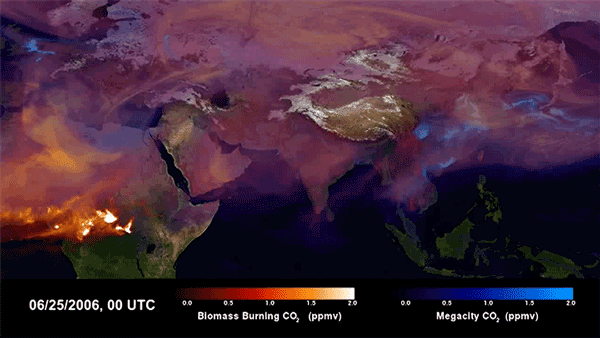News•November 12, 2015
These Are The NASA Tools Tracking Our CO2

By Brian Kahn
Carbon dioxide, or CO2 for short. It’s simple gas that makes up a small part of our planet’s atmosphere. And yet it’s at the root of one of the biggest problems of the 21st century (that would be climate change, for the record).
NASA scientists have been keeping an eye on the movement of CO2 across land, air and sea in an effort to zero in on the changes in store for our planet.
CO2 from wood burning and urban sources.
Credit: NASA

CO2 concentrations in the atmosphere are the highest they’ve been in 400,000 years. Despite the commitments to try and rein in carbon pollution, there’s still little sign human emissions will slow anytime in the near future, let alone drop to zero.
That has the world on track to cross the symbolic atmospheric CO2 threshold of 400 parts per million (ppm) permanently this year or early next year. And it also means that the climate will continue to change leading to warmer temperatures, higher and more acidic oceans, and shifts in extreme weather.
RELATEDDrying Amazon Could Be Major Carbon Concern
Climate Model Shows Limits of Global Emissions Pledges
NASA Satellite Sends Back Most Detailed View of CO2
Yet CO2 and corresponding impacts would be a lot higher if it weren’t for plants, like giant sequoias to microscopic plankton, that absorb about half of all human CO2 emissions in a given year. That’s why NASA is interested in monitoring the world’s greenery or what they’ve termed the “other half” of the carbon equation.
Factors such as El Niño, drought and warm weather in the Arctic all affect how much CO2 is taken up by the natural world. Scientists are beginning to understand those, but what they’re even more curious about is how human-influenced warming could further change plants’ ability to absorb CO2.
“Some years, almost all of it stays in atmosphere and some years almost none of it remains in the atmosphere. So in those years it must all be absorbed into ocean and land,” Mike Freilich, the head of NASA’s Earth Science Division, said.
Freilich and other NASA scientists have been using a mix of models and satellites to deconstruct CO2’s movements and mysteries. That includes NASA’s Orbiting Carbon Observatory-2 (OCO-2), which just finished its first year of collecting carbon data.
Atmospheric CO2 concentrations in early spring, when plants in the northern hemisphere are still dormant, vs. summer, when plants draw CO2 out of the atmosphere.
Credit: NASA
“OCO-2 gathers 100,000 high quality measurements of CO2 across the globe daily,” said Annmarie Eldering, OCO-2 deputy project scientist.
She said instruments aboard the satellite can detect minute changes and collect up to 100 times more data than previous satellites. The data show changes of as little as 1 ppm over a certain location and can allow scientists to spot potential CO2 hot spots.
For example, preliminary data shows that there’s been more CO2 since spring over the tropical Pacific Ocean, where El Niño has been exerting its influence. Eldering said it’s too early to say if it’s related specifically to El Niño, “but based on info we have, we can say this year is a little different than what we had before.”
Lesley Ott, a NASA researcher who works on the model, said that OCO-2 is helping test the limits of CO2 models and that better observations will ultimately lead to improvements.
“Now that we have OCO-2, we can do atmospheric observations to tell us how good our model-based (CO2) estimates were to begin with,” she said. “The motivation of all of this is to make models better and predict how the carbon cycle is going to change over the coming years.”
And the motivation for all of these efforts is to influence decision makers to make scientifically-informed choices. Some NASA carbon monitoring tools are already being used in Maryland to improve forest policy and conservation. Next up is this bigger picture climate change thing.
You May Also Like:
Once Stable Greenland Glacier Facing Rapid Melt
New Fees Seen to Weaken Demand For Rooftop Solar
Energy Transition Underway Ahead of Paris Climate Talks
Paris Pact May Hinge on ‘Loss and Damage’ Dispute
